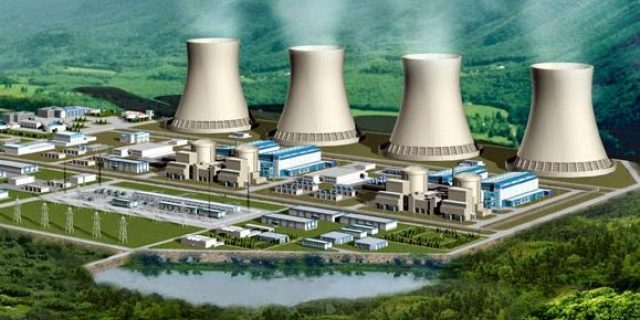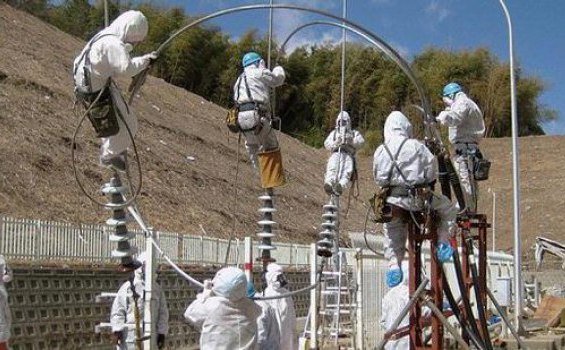**NUCLEAR POWER PLANT**

NUCLEAR POWER PLANT
Some materials present in nature, such as uranium, when reacted with neutrons, will undergo division reactions and produce energy that can be used to heat water up into steam. Furthermore, the steam can be used to rotate the turbine and generate electricity. The first commercial nuclear power plant was the Magnox Reactor, built in the 1950s in England.
While the use of radioisotopes deliberately for a particular purpose conducted by George du Hevesy in 1911. At that time, he was still a student who was researching natural radioactive materials. Being from out of town and from a humble family he lives in a dormitory that also serves basic food everyday. At one point, he suspected that the food served was mixed with leftovers from the previous day, but he could not prove his suspicions. For that he put a small amount of radioactive material into the food that was deliberately not spent. The next day when the same kind of food is served, he checks the food using a simple radiation detection device, and it turns out he detects the radioisotope in the food he suspects. From then on he developed the use of radioactive material as a tracer for various purposes.
Field of Energy: Nuclear Power Plant
Difference between Nuclear Power Plant and Fossil Fuel Power Plant
All power plants, including nuclear power plants, have a relatively similar working principle. Fuel (whether in the form of coal, gas or uranium) is used to heat the water that will become steam. Steam rotates the turbine and then the turbine spins a generator that will generate electricity.
The striking difference is that nuclear power plants do not burn fossil fuels, but use fuel can be split (fissile material). In the reactor, the fissile material is reacted with neutrons resulting in a chain reaction that produces heat. The resulting heat is used to produce high-pressure water vapor, then the steam is used to drive the turbine. With the use of fissile material, means not producing CO2, acid rain, or other toxic gases such as if using fossil fuels.

The use of nuclear engineering in the form of nuclear power plant began to be developed commercially since 1954. At that time in Russia (USSR), built and operated one unit of high pressure light water plant (VVER = PWR) which a year later reaches 5 MWe power. In the United States also operated the same type of reactor, with a power of 60 MWe. In 1956 the UK developed a gas cooled reactor (GCR = gas cooled reactor) with a power of 100 MWe. In 1997 around the world both developed and developing countries have operated as many as 443 units of nuclear power plants spread in 31 countries with a contribution of about 18% of world electricity supply with total power generation reached 351,000 MWe with 36 units of nuclear power plant is in the construction phase in 18 country.
Nuclear is Not an Alternative to the People
Since the 70s, the government continues to insist on building a Power Plant (PLTN). In 1998, the plan to build a nuclear power plant in Muria failed due to the economic crisis. The reason for the electricity crisis continues to be an excuse by the government to promote nuclear power plants.
Nuclear Impact on People and the Environment
Nuclear reactors are very dangerous and threaten the safety of the human soul. Radiation caused by this nuclear reactor is twofold. First, direct radiation, the radiation that occurs when radio is transmitted directly on the skin or the human body. Second, indirect radiation. Indirect radiation is the radiation that occurs through food and drink contaminated with radioactive substances, either by air, water, or other media.
Both, either direct or indirect radiation, will affect the function of organs through its forming cells. Sensitive organs will and will become damaged. The cells of the body when polluted by the radio are described as follows: the occurrence of ionisation due to radiation can damage the relationship between atoms and molecules of the living cell, can also change the condition of the atom itself, change the original function of the cell or even can kill it. In principle, there are three consequences of radiation that can affect the cell. First, the cell will die. Second, cell multiplication, eventually can lead to cancer, and third, damage can occur in the egg or testicle, which will start the process of the babies handicapped. In addition, it also causes burns and an increase in the number of cancer patients (thyroid and cardiovascular) as much as 30-50% in Hryvnia, respiratory inflammation, and respiratory arrest, as well as psychological and stress problems resulting from radiation leaks.
There are several latent dangers of nuclear power plants to consider. First, human error can cause leaks, whose radiation range is so wide and fatal to the environment and to living things. Second, one that is produced by nuclear power plants, namely Plutonium has a very powerful warhead. For this Plutonium, one of the raw materials of making nuclear weapons. Hiroshima City was destroyed only by 5 kg of Plutonium. Thirdly, the waste produced (Uranium) could have an effect on genetics. In addition, nuclear power emits active radio radiation which is very harmful to humans.


PRINCIPLE OF WORK PLTN
The working principle of nuclear power plant is almost similar to the workings of other fossil fuel power plants (PLTU). If the power plant uses a boiler to generate heat energy, the NPP replaces it using a nuclear reactor.
As shown in Figure 1, the PLTU uses coal fuel, petroleum, natural gas and so on to produce heat by burning, then the heat generated is used to heat the water in the boiler to produce water vapor, the obtained moisture is used to rotate the turbine steam, from here the generator can generate electricity because it goes spinning seporos with steam turbine.
Nuclear power plant also has the same working principle that is in the reactor occurs fission reaction of uranium fuel to generate heat energy, then the water inside the reactor is boiled, the vapor kinetic energy obtained is used to rotate the turbine so as to generate electricity to be forwarded to the transmission network
Reference :
- http://www.batan.go.id/pusdiklat/elearning/proteksiradiasi/pengenalan_radiasi/3-1.htm
- http://www.alpensteel.com/article/124-111-energi-nuklir--pltn/861--mengenal-pembangkit-listrik-tenaga-nuklir
- https://indone5ia.wordpress.com/2012/02/17/prinsip-kerja-pembangkit-listrik-tenaga-nuklir/
BEST REGARD @salehts06
 ,.
,.
)
Congratulations @salehts06! You have completed some achievement on Steemit and have been rewarded with new badge(s) :
Click on any badge to view your own Board of Honor on SteemitBoard.
To support your work, I also upvoted your post!
For more information about SteemitBoard, click here
If you no longer want to receive notifications, reply to this comment with the word
STOP